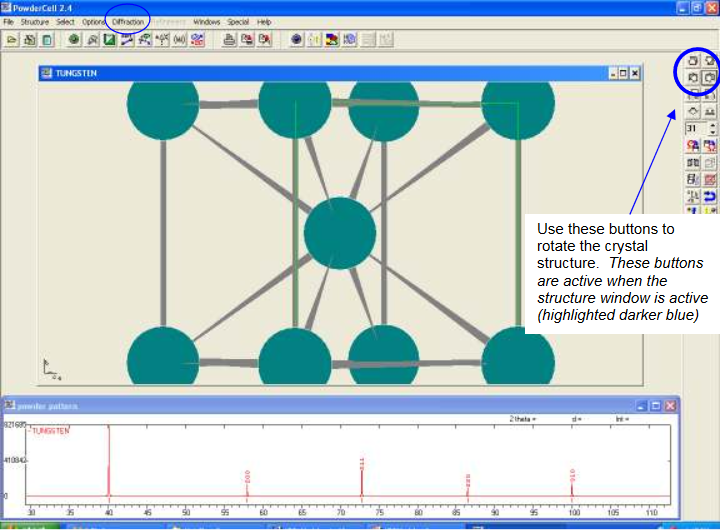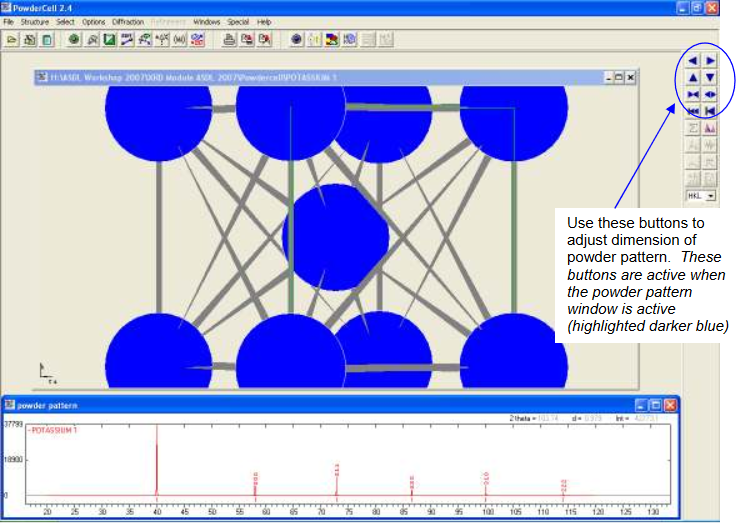Crystallography
- Page ID
- 78105
Utilization of X-Ray Diffraction
Crystallography: Diffraction data provides information on the structures of crystalline solids
- The symmetry in structures shows itself in the diffraction by the appearance and disappearance of characteristic reflections.
- The intensity of the diffracted beams depends on the arrangement and atomic number of the atoms in the repeating motif, called the unit cell. Unit cells describe the symmetry of all structures.
What are some of the key crystallography concepts?
The emphasis of this learning module is not on obtaining a detailed understanding of crystal structures. However a few key concepts are useful in understanding crystallography and results obtained using XRD.
Key Concepts
- Crystal structures are the periodic arrangement of atoms in a crystal
- Structures are defined using lattices (infinite array of points in space)
- Common lattices are shown below (note the spheres represent lattice points, NOT atoms)

- Common lattices are shown below (note the spheres represent lattice points, NOT atoms)
www.chem.ox.ac.uk/icl/heyes/s...1.html#anchor2
- Unit cells are used to describe the smallest repeating structure in a lattice of a crystalline material.
- These repetitions are what give rise to the constructive interference defined by Bragg’s Law
Note: It is important to recognize that simple examples shown in this module have atoms existing within lattice sites. This is rarely the case beyond metals and simple salts.
Let’s examine in the next section how different unit cells and atoms influence diffraction using a program called Powdercell.
Powdercell is a freeware program that can be downloaded.
Werner, K. Nolze, G. Powder Cell 2.3
POWDER CELL Analysis
The following activity allows you to evaluate factors that influence diffraction, creating unique diffraction patterns for a material.
It requires a free ware program (Powdercell) that can be downloaded, but does not have to be installed on a computer to be operational.
Files for Powdercell Activity
Tungsten
Potassium 1
Potassium 2
Tungsten heated
Fe BCC
Fe FCC
Initial Analysis
- Open Powdercell 2.3
- Under File select Tungsten

Notes: If you do not immediately see a diffraction pattern, go under diffraction (top menu) and select Diffraction On.
Hints:
- The diffraction from the crystal structure is denoted at different scattering angles (2θ). The y-axis is the intensity of the diffraction at a given angle.
- Above the diffraction peaks are miller indices (h,k,l). These are a shorthand notation used to describe the crystallographic planes and directions in a material. Depending on the crystal structure different planes will constructively diffract.
Questions:
- What do you notice in the diffraction pattern for tungsten? (i.e. what diffraction peaks are present and at what angle of diffraction)
- Tungsten exhibits a body centered cubic (BCC) structure. What would the diffraction pattern look like for Potassium, which also exhibits a BCC structure?

- In actuality the unit cell for Potassium is much larger a=b=c = 5.247Å vs. the 3.180 Å for Tungsten. Open up the file Potassium 2. Compare this to Potassium 1. What do you notice?
- Temperature will also change a unit cell dimension for a compound. Let’s look at the Tungsten structure again. Under elevated temperatures the dimensions of the unit cell change from a=b=c = 3.180 Å to a=b=c= 3.200 Å. Do you think this will change the diffraction pattern?
Examine the diffractions of Tungsten room temperature and tungsten heated using Powder cell. (Compare the files Tungsten and Tungsten heated). What do you observe?
- Sometimes temperature can also cause phase transitions in a material. For example α-Fe exhibits a BCC structure at room temperatures. However, above 912°C and up to 1401°C alpha iron undergoes a phase transition from BCC to the FCC configuration of γ-Fe, called austenite. Compare the differences between the patterns for BCC (alpha) and FCC (gamma) iron. (Use files Fe BCC and Fe FCC.)
What is different in the crystal structures and diffraction patterns between FCC and BCC?
XRD Analysis-Summary
From diffraction patterns one can find the crystal structure of an unknown material. In addition one can also determine factors such as the orientation of single crystals, or measure the size and shape of crystalline regions. There are several X-ray diffraction techniques. Two of the most common are:
- Single crystal X-ray diffraction: used to solve structure of crystalline materials ranging from inorganic compounds to complex macromolecules such as proteins or polymers. You can learn everything about a crystal structure, but requires a single crystal. Although obtaining single crystals is difficult, single crystal X-ray crystallography is a primary method for determining the molecular conformations of biological interest such as DNA, RNA and proteins.
- Power X-ray diffraction: used to characterize crystallographic structure, grain size, and preferred orientation in polycrystalline or powder solid samples. This is a preferred method of analysis for characterization of unknown crystalline materials. Compounds are identified by comparing diffraction data against a database of known materials. It can be used to follow phase changes as a function of variable such as temperature, pressure.
This module focuses on providing an introduction to X-ray diffraction Powder X-ray analysis to identify crystalline materials.


